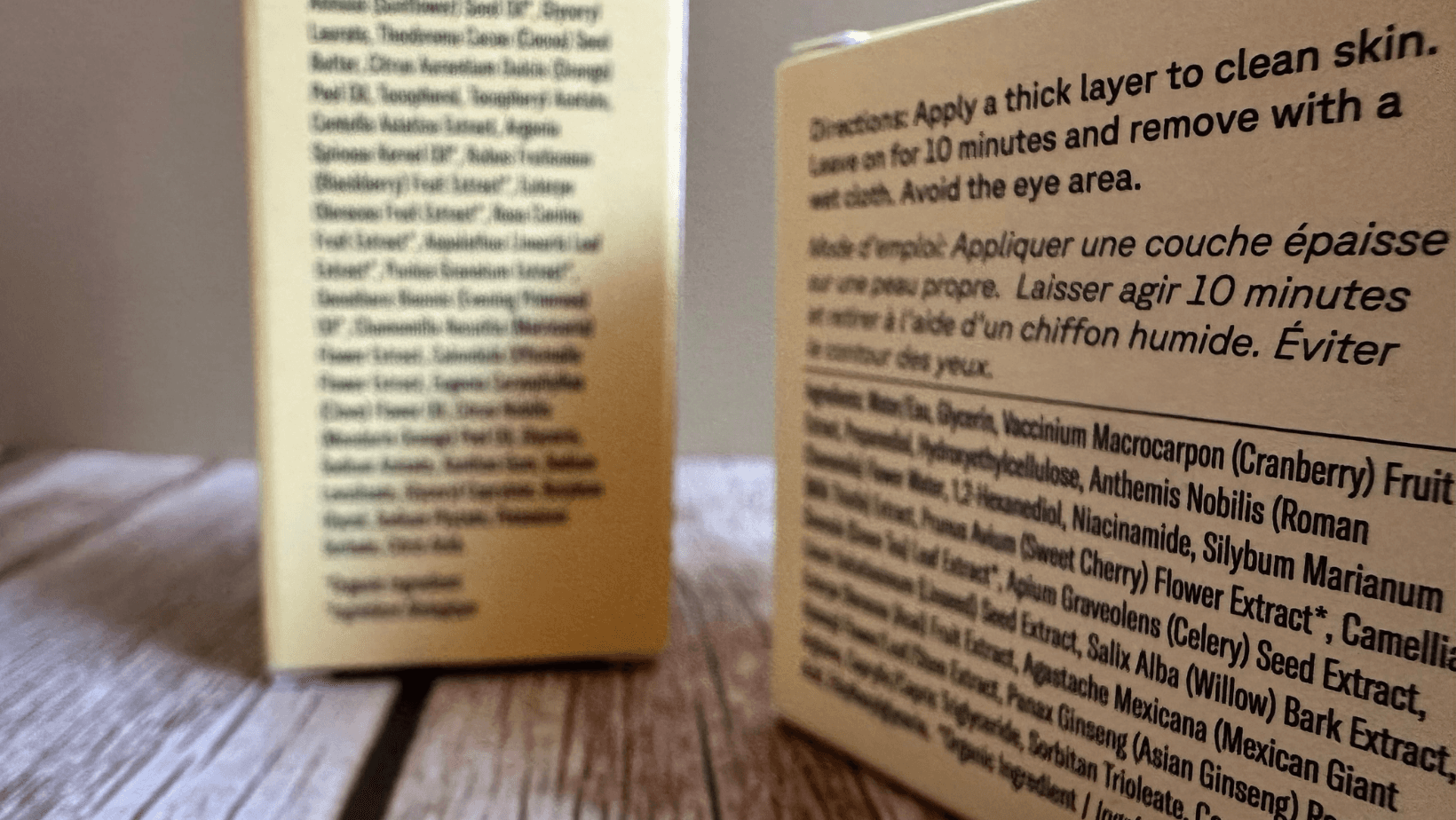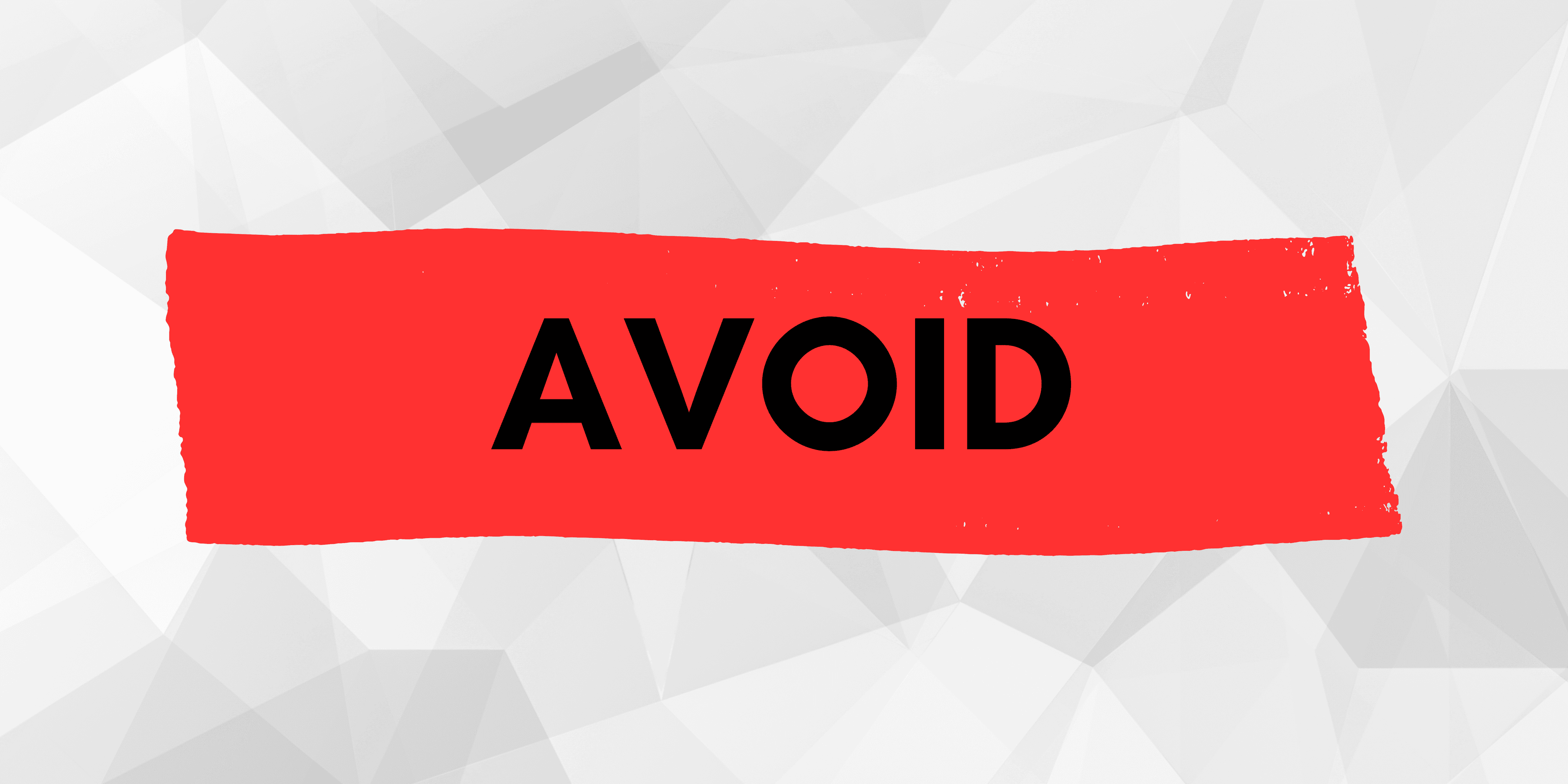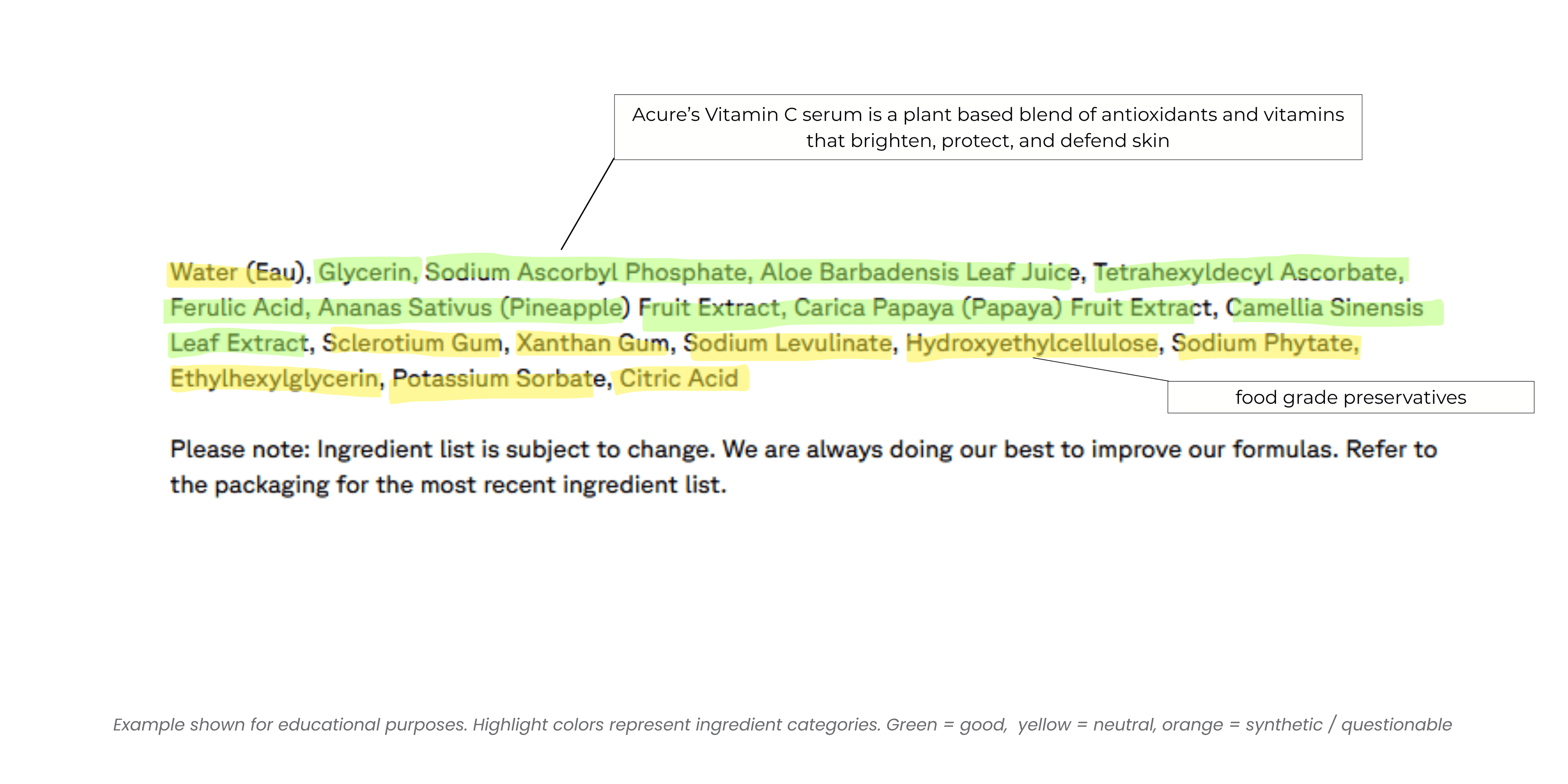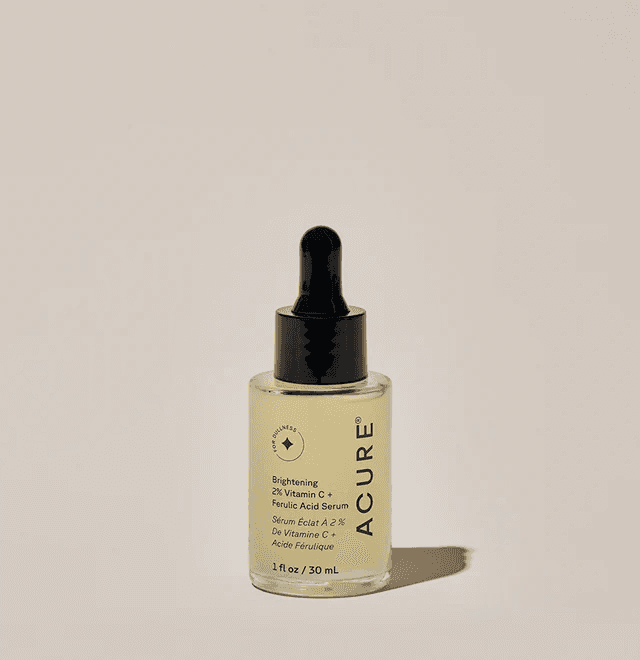A Simple Guide to Reading Beauty Product Labels
Date Published: 11/2/2025
A clear guide to reading skincare ingredient labels. Understand which ingredients are harmful, neutral, or beneficial — and how to avoid greenwashed marketing.

This post contains affiliate links. If you click and purchase, I may earn a small commission at no extra cost to you. Read my full disclosure here. Learn more
Did you know that “clean”, “natural”, and “vegan” aren’t regulated by any third party agency? Any brand can print them on their packaging. The only way to really know what you’re buying is if you read the ingredient list, which IS regulated. When shopping for skincare or personal products, reading the label is important because the claims on the front of the package may not tell the whole story. What you apply to your skin, inhale, or leave overnight, interacts with your body and the planet.

Is it really eco? Or just plastic with the label slapped on?
Brands that are transparent with their ingredients and production tell their whole story. But not all labels do the same.
Brands that are transparent with their ingredients and production tell their whole story. One example is Acure, a clean skincare company that clearly lists each ingredient on the label and keeps its formulas plant-based, vegan, and accessible.
Here are the ingredients we prefer to avoid, others that are neutral, and some that are proven to be beneficial. Here’s your label decoding guide.
Ingredients to Avoid

These ingredients often mean the product contains synthetic fillers, potential hormone-disruptors, or materials that contribute to microplastics and build up over time.
- Fragrance / Parfum: this is an umbrella term that hides dozens of chemicals and VOCs (volatile organic compounds). A study found that fragranced baby-products emitted hundreds of VOCs, while a report by the Breast Cancer Prevention Partners found that fragrance ingredients are often secret and hidden under the term “fragrance”.
- Sulfates (SLS, SLES): sulfates are harsh detergents that strip skin and disrupt the skin barrier. They are strong detergents used for foaming, but research shows that they can reduce hydration and increase transepidermal water loss by altering the surface of the skin. If you have sensitive or barrier compromised skin, you should look to limit exposure to SLS.
- Parabens: anything that starts with “methyl-”, “propyl-”, “butyl-”, are preservatives linked to endocrine disruption. These chemicals mimic estrogen in the body. For example, a study summarized that parabens may act on hormone receptors and disrupt steroid hormone synthesis and secretion. With that said, regulatory assessments such as those done by the FDA notes that parabens show less estrogen-like activity as compared to natural estrogen.
- Phthalates: may be found in fragrances, and disrupt the endocrine system. For those using fragranced products, this can build up over time. A review found that phthalates and other endocrine disrupting chemicals in personal care products.
- PEGs and Polysorbates: they are petroleum-based emulsifiers that can be contaminated with impurities. Since they’re derived from petroleum, they often get contaminated during the manufacturing process, and many clean beauty enthusiasts avoid the,
- Silicones (dimethicone, cyclopentasiloxane): these ingredients give products a smooth feel but trap buildup and microplastics. They build up on the skin and trap pore clogging residues. Silicones are now under regulatory pressure for environmental persistence. Many silicones have been banned in the EU, where they have been classified as PBT (persistent, bioaccumulate, toxic).
Ingredients that are neutral

These next few ingredients are generally safe for the skin and the planet, when responsibly sourced. But they’re neither super effective nor deeply problematic. Think of them as behind-the-scenes workers that make your favorite products silky, blendable, and shelf-safe
- Glycerin: A powerful humectant that draws moisture from the air into skin to keep it hydrated and plump. Most glycerin is synthetically derived to ensure purity, but vegetable glycerin is also common. It's one of the most skin compatible hydrators on the market today and is found in most products, from serums, to cleansers.
- Cetearyl alcohol / stearic acid: these are fatty alcohols (not the drying kind) used as stabilizers for emulsions (when oil and water are mixed) and are derived from coconut or palm oils.
- Xanthan gum / guar gum: natural thickeners derived from plants or fermentation. They help products maintain it's consistency and prevents them from separating. Common ingredients in "clean" formulas and work well on sensitive skin.
- Phenoxyethanol: a preservative that’s safe in very small concentrations (<1%), it prevents bacterial growth and extends shelf-life. Clean beauty brands use it as a milder alternative to parabens.
- Caprylyl glycol: it’s a mild skin-conditioning agent that adds smoothness to creams. Commonly derived from coconuts and doubles as a mild preservative booster.
Ingredients that are safe

Good ingredients should nourish the skin and should be naturally sourced or plant derived. They should also have evidence of clear skin benefits and be manufactured responsibly and transparently.
- Aloe vera, rose water, chamomile extract: these ingredients are used as soothing bases to calm, hydrate, and reduce redness.
- Vitamin C (ascorbic acid): often paired with ferulic acid, these two antioxidants work in synergy to brighten skin, protect from free radical damage caused by UVs, and boosts collagen.
- Niacinamide (vitamin B3): Derived from niacin, found in yeast and grains, it strengthens the skin barriers, balances oil production, refines pores, and evens out the skin tone. It's one of the most gentle actives in skincare today.
- Oils: Jojoba, argan, avocado oils mimic the skin’s natural oils, which means they absorb well without clogging pores. Jojoba is light and balancing, argan is Vitamin E rich, and avocado oil gives the skin deep nourishment with fatty acids that support elasticity.
- Bakuchiol: a natural retinol alternative that supports cell turnover and collagen production, but without the common irritation, redness, or flaking. Safe for sensitive skin and pregnancy friendly.
- Plant peptides/plant extracts: these help repair and hydrate without synthetics. Small amino acid chains that help the skin rebuild collagen, retain water, and look more firm. Extracts such as green tea, licorice root, and ginseng are rich in antioxidants.
Examples from real products

Let's break down the ingredients of under eye patches from a very popular beauty company

Acure's formula is packed with natural ingredients.

Acure Vitamin C Brightening Serum
Acure’s Vitamin C Brightening Serum combines antioxidant-rich Vitamin C, Ferulic Acid, and Aloe Vera to help boost radiance and even skin tone naturally. This lightweight formula absorbs quickly, all without parabens, sulfates, or synthetic fragrance.
How to spot "greenwashing"
Many brands use nature-inspired marketing, but their products can still contain synthetic fillers, excess packaging, or unsustainable ingredients. Here's how to discern real sustainability from surface-level claims.
1. Trust the Ingredient List, not Vague Claims
Front labels are designed to grab your attention and sell. Words such as plant powered, vegan, organic, and non-toxic sound good but these claims are rarely regulated. The real truth lies in the back of the box, on the ingredient list.
Tip: When in doubt, cross-check an ingredient on the EWG skin deep database. It ranks them by safety and environmental impact.
2. Check for third-party certifications.
Independent certifications can help verify a brand's environmental and ethical claims. Look for trusted marks such as:
- EWG Verified: ensures ingredients meet health and transparency standards
- Climate Neutral Certified: The company measures, reduces, and offsets its carbon emissions. To learn more more details, read our Climate Neutral Certified Post
- Leaping Bunny or Cruelty-Free International: Guarantees no animal testing at any stage of production
3. Be aware of vague or misleading phrases
Some of the most common greenwashing phrases sound wholesome, but have no legal or scientific basis.
- Chemical-free: Everything is made of chemicals. What matters is which ones, and how they're processed
- Non-toxic: There's no regulatory definition for this in beauty products.
- Dermatologist Approved: Usually means tested by a dermatologist, not endorsed by a regulatory board.
- Sustainable Packaging: Ask whether it's recyclable, compostable, or made from post consumer materials. The word alone doesn't say everything.
4. Evaluate the packaging itself
Is the product labeled “eco”, but uses multiple layers of plastic, foil, and paper packaging, or having an overly large package for a minimal product? That's a red flag. Choose brands that use glass, aluminum, or single material packaging that clearly communicate recycling instructions.
5. Double-check the ingredient list for hidden synthetics
Marketing terms like “clean” or “natural” can mask the use of petrochemical derivatives, silicones, or polymers that build up on skin and persist in the environment.
Scan for suffixes like “-eth,” “-cone,” “-siloxane,” or “PEG-”. These often point to synthetic fillers, silicones, or emulsifiers derived from petroleum.
Tip: Not all synthetics are harmful. Some, like niacinamide or glycerin are lab produced for stability. The key is transparency about their source and purpose.
6. Learn the brand's bigger story
Sustainability doesn't stop at just the ingredients. Look at how a brand discloses its manufacturing, sourcing, and people. Do they:
- Publish sustainability or impact reports?
- Use renewable energy?
- Fair-trade ingredients?
- Offer recycling or refill programs?
If a brand doesn't talk about their processes, they might be prioritizing aesthetic sustainability over real accountability.
The more you understand what goes in your products, the easier it is for you to choose what aligns with your values. Transparency and the highest quality ingredients set the new standard, and that’s precisely the ethos I aim for.
Sources
- FDA on Cosmetics
- Fragrant consumer products a key source of ozone-forming pollution in New York City
- Effect of Sodium Lauryl Sulfate (SLS) Applied as a Patch on Human Skin Physiology and Its Microbiota
- Parabens in Cosmetics
- Pthalates
- Phthalates and Their Impacts on Human Health
- Niacinamide - mechanisms of action and its topical use in dermatology
Tags: beauty, skincare, eco-friendly
Canonical: https://www.thegoodstandard.org/blog/a-simple-guide-to-reading-beauty-product-labels